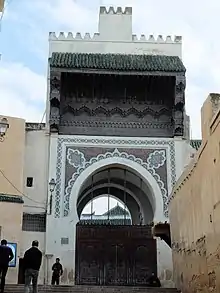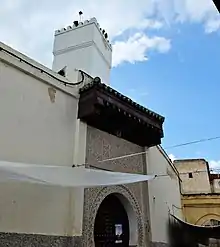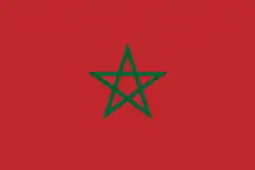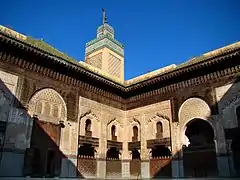Andalusian Mosque
Andalusian Mosque or Mosque of the Andalusians (Arabic: مسجد الأندلسيين, romanized: Masjid al-Andalusiyyin)[1][2] is a major historic mosque in Fes el Bali, the old medina quarter of Fez, Morocco. The mosque was founded in 859-860, making it one of the oldest mosques in Morocco. It is located at the heart of a district which was historically associated with Andalusi immigrants, from which it takes its name. It has been renovated and expanded several times since then. Today, it is one of the relatively few remaining Idrisid-era establishments and one of the main landmarks of the city.
| Mosque of the Andalusians | |
|---|---|
مسجد الأندلسيين | |
 Main entrance portal of the mosque (north side) | |
| Religion | |
| Sect | Sunni Islam |
| Location | |
| Location | Fes, Morocco |
| Geographic coordinates | 34.0347°N 4.5805°E |
| Architecture | |
| Type | mosque |
| Style | Moroccan, Islamic |
| Date established | 859-60 CE (245-246 AH) |
| Minaret(s) | 1 |
Description

According to historical sources like al-Jazna'i, the mosque was founded in 859-860 by Maryam bint Mohammed bin Abdullah al-Fihri (sister of Fatima al-Fihri, who founded the Qarawiyyin Mosque at the same time). Construction was also aided by additional funds donated by a group of local residents of Andalusi background.[3] The latter had come to the city as refugees in 818, fleeing the city of Cordoba after a failed uprising which resulted in severe repressions from the Ummayyad emir al-Hakam I.[4]:46–47 The original construction was modest; according to the 12th-century Andalusian geographer Al-Bakri, the mosque consisted of seven vaults and a small sahn where a walnut tree and several other trees were planted. The mosque had access to abundant water from an artificial water channel known as Wadi Masmuda.[5][2]
In the 10th century, the Umayyads of Cordoba erected the minaret which survives up until today. The minaret is square-shaped and has simple decorations on its frame. It is built to resemble the minaret of the al-Qarawiyyin Mosque. During the rule of Obaidullah, a governor of Fez during the Fatimid-era, the mosque became the place for khutbah (religious sermon) during the Friday Prayer, replacing the position of the Mosque of Al-Ashyakh which was the first mosque built in the eastern settlement. Muhammad al-Nasir, the fourth Almohad caliph, ordered the construction of the gate during 1203-1207 which overlooks the northern facade. The gate is topped by two domes, one of which is built of carved plasters and another is built of cedar wood, and decorated by the combination of wooden zellij and qashani works. It was restored during the Alaouite period. Several historians, artists, and scholars, including the orientalist Georges Marçais praised the architecture as a masterpiece of Moroccan architectural style. The caliph built as well a water tank, a fountain on the northern facade of the building which resembles that of the al-Qarawiyyin Mosque, and an apartment made of stone for the imams of the mosque on the second floor above the prayer hall for women. During the Marinid period, several parts of the building including the ceiling, beams, and fountain were restored. The mosque also provided seven courses for education and contained two libraries, similar to the al-Qarawiyyin Mosque, making it the second most important mosque in the medina of Fez.[5][2]
References
| Wikimedia Commons has media related to Al-Andalus Mosque. |
- Petersen, Andrew (1996). "Fez". Dictionary of Islamic Architecture. Routledge. pp. 87.
- Jami' al-Andalusiyyin. Archnet. Retrieved January 23, 2018.
- Terrasse, Henri (1942). La mosquée des Andalous à Fès. Paris: Les Éditions d'art et d'histoire.
- Le Tourneau, Roger (1949). Fès avant le protectorat: étude économique et sociale d'une ville de l'occident musulman. Casablanca: Société Marocaine de Librairie et d'Édition.
- Mezzine, Mohamed. "Andalusian Mosque". Discover Islamic Art, Museum With No Frontiers. Retrieved January 21, 2021.



